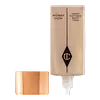What's inside
What's inside
 Key Ingredients
Key Ingredients

 Benefits
Benefits

 Concerns
Concerns

 Ingredients Side-by-side
Ingredients Side-by-side

Water
Skin ConditioningDimethicone
EmollientCyclopentasiloxane
EmollientPolysilicone-11
Butylene Glycol
HumectantGlycerin
HumectantSilica
AbrasiveMica
Cosmetic ColorantSqualane
EmollientCI 77891
Cosmetic ColorantNylon-12
Isononyl Isononanoate
EmollientPhenoxyethanol
PreservativeHydroxyethyl Acrylate/Sodium Acryloyldimethyl Taurate Copolymer
Emulsion StabilisingSodium Potassium Aluminum Silicate
Avena Sativa Kernel Extract
AbrasiveEthylhexylglycerin
Skin ConditioningIsohexadecane
EmollientPEG-10 Dimethicone
Skin ConditioningTocopheryl Acetate
AntioxidantCarbomer
Emulsion StabilisingPolysorbate 60
EmulsifyingPolysorbate 40
EmulsifyingHydrolyzed Viola Tricolor Extract
Skin ProtectingCaramel
Cosmetic ColorantAllantoin
Skin ConditioningAloe Barbadensis Leaf Juice
Skin ConditioningDisodium EDTA
Camellia Oleifera Seed Oil
Skin ConditioningRosa Canina Fruit Oil
EmollientAmmonium Polyacryloyldimethyl Taurate
Emulsion StabilisingNylon-12 Fluorescent Brightener 230 Salt
Sodium Hydroxide
BufferingCI 77491
Cosmetic ColorantSodium Hyaluronate
HumectantSodium Lactate
BufferingSorbitan Isostearate
EmulsifyingCoco-Glucoside
CleansingCI 77492
Cosmetic ColorantParfum
MaskingCI 77499
Cosmetic ColorantPolyvinylalcohol Crosspolymer
Helianthus Annuus Seed Oil
EmollientPalmitoyl Tetrapeptide-7
Skin ConditioningPalmitoyl Tripeptide-1
Skin ConditioningTin Oxide
AbrasiveNicotiana Sylvestris Leaf Cell Culture
Skin ConditioningRosa Damascena Flower Oil
MaskingTocopherol
AntioxidantPlumeria Rubra Flower Extract
Skin ConditioningAnthemis Nobilis Flower Oil
MaskingCitronellol
PerfumingGeraniol
PerfumingWater, Dimethicone, Cyclopentasiloxane, Polysilicone-11, Butylene Glycol, Glycerin, Silica, Mica, Squalane, CI 77891, Nylon-12, Isononyl Isononanoate, Phenoxyethanol, Hydroxyethyl Acrylate/Sodium Acryloyldimethyl Taurate Copolymer, Sodium Potassium Aluminum Silicate, Avena Sativa Kernel Extract, Ethylhexylglycerin, Isohexadecane, PEG-10 Dimethicone, Tocopheryl Acetate, Carbomer, Polysorbate 60, Polysorbate 40, Hydrolyzed Viola Tricolor Extract, Caramel, Allantoin, Aloe Barbadensis Leaf Juice, Disodium EDTA, Camellia Oleifera Seed Oil, Rosa Canina Fruit Oil, Ammonium Polyacryloyldimethyl Taurate, Nylon-12 Fluorescent Brightener 230 Salt, Sodium Hydroxide, CI 77491, Sodium Hyaluronate, Sodium Lactate, Sorbitan Isostearate, Coco-Glucoside, CI 77492, Parfum, CI 77499, Polyvinylalcohol Crosspolymer, Helianthus Annuus Seed Oil, Palmitoyl Tetrapeptide-7, Palmitoyl Tripeptide-1, Tin Oxide, Nicotiana Sylvestris Leaf Cell Culture, Rosa Damascena Flower Oil, Tocopherol, Plumeria Rubra Flower Extract, Anthemis Nobilis Flower Oil, Citronellol, Geraniol
 Reviews
Reviews

Ingredients Explained
These ingredients are found in both products.
Ingredients higher up in an ingredient list are typically present in a larger amount.
Cyclopentasiloxane, or D5, is a silicone used to improve texture of products and trap moisture.
D5 is considered lightweight and volatile. Volatile means it evaporates quickly after application. Once evaporated, D5 leaves a thin barrier that helps keep skin hydrated.
It is also an emollient. Emollients help soften the skin and prevent water loss. Silicones create a silky texture in products. D5 helps other ingredients become more spreadable.
Studies show D5 is safe to use in skincare products. We recommend speaking with a skincare professional if you have concerns.
Learn more about CyclopentasiloxanePeg-10 Dimethicone is silicone with conditioner and emulsifier properties. It mostly acts as an emollient in skincare and and humectant in haircare.
According to the manufacturer, acidic formulations decrease the stability of this ingredient. It works best in neutral or near neutral formulations.
Polysilicone-11 is a film-forming silicone that creates a non-tacky and matte finish on the skin. It's commonly used to improve texture, absorb excess oil, and help active ingredients spread evenly.
Due to its "rubber-like" structure, it stays on the skin's surface instead of being absorbed. On the skin, it creates a flexible layer that enhances wearability and stability.